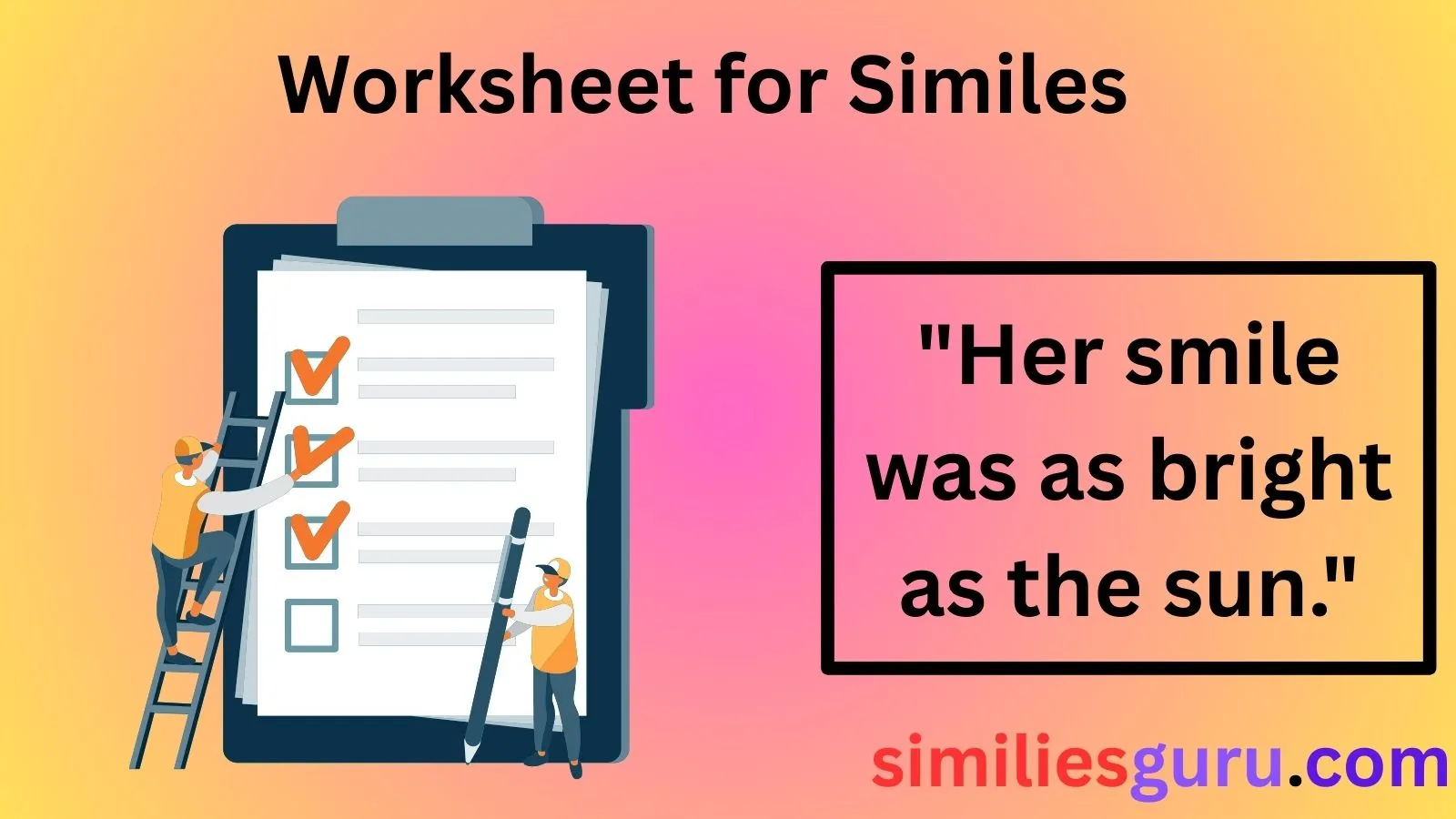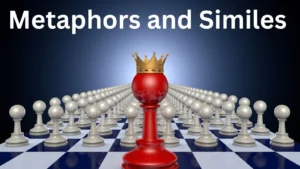Similes are a powerful tool in the English language, helping to create vivid images in the reader’s mind by comparing one thing to another using “like” or “as.” They bring a poetic touch to both everyday conversations and literary works, allowing the writer or speaker to convey emotions and ideas more effectively. However, the context and tone in which a simile is used can greatly influence its impact. This article will explore different ways to express similes in various contexts, offering polite, professional, and casual alternatives to the phrase “worksheet for similes.” It will also highlight how you can choose the best alternatives based on the situation, providing a collection of user-friendly examples that are optimized for Google.
What is a Simile?
A simile is a figure of speech that directly compares two different things using the words “like” or “as.” The goal of a simile is to highlight similarities between two things, making it easier for the reader or listener to understand the idea being expressed. For example:
- “Her smile was as bright as the sun.”
- “He was as strong as an ox.”
These comparisons make descriptions more vivid and engaging, helping the audience to visualize the scene or concept more clearly.
Similes are commonly used in both creative and everyday writing. They help add color, drama, and depth to writing, whether in storytelling, poetry, or casual conversation.
Why Use a Worksheet for Similes?
A worksheet for similes can be a helpful tool for anyone looking to improve their language skills, whether you’re a student, a teacher, or simply someone trying to enrich your vocabulary. Worksheets allow learners to practice using similes in a structured manner, offering examples and exercises to reinforce the correct usage of similes in different contexts. Whether the goal is to use similes to convey a certain mood, tone, or emotion, a worksheet can guide users through exercises that help make these comparisons more effective.
In this article, we will explore multiple alternatives to the phrase “worksheet for similes” and give examples to illustrate their usage.
Alternatives to “Worksheet for Similes”
The term “worksheet for similes” can be rephrased in a variety of ways, depending on the context and tone you’re aiming for. Below are some polite, professional, and casual alternatives to consider.
Polite Alternatives
- Simile Practice Exercises
- Simile Learning Sheet
- Simile Study Guide
- Comparative Language Activity Sheet
- Simile Expansion Worksheet
- Simile Development Worksheet
- Simile Exploration Worksheet
These alternatives can be used in educational settings or any scenario where formal language is needed. They’re appropriate for use with students or adults in academic environments, helping them build a deeper understanding of similes in a structured manner.
Professional Alternatives
- Simile Construction Worksheet
- Simile Application Worksheet
- Simile Usage Worksheet
- Simile Integration Worksheet
- Advanced Simile Practice Sheet
- Simile Skill Building Worksheet
- Simile Writing Exercise Sheet
Professional alternatives tend to have a more focused, skill-building tone. These can be used in corporate communication, workshops, or for anyone looking to enhance their language skills in a professional setting.
Casual Alternatives
- Fun Simile Practice Sheet
- Simile Writing Fun Sheet
- Simile Discovery Worksheet
- Creative Simile Practice Sheet
- Simile Learning Fun Sheet
- Simile Comparison Activity Sheet
- Everyday Simile Practice Worksheet
These more casual options are perfect for younger audiences or informal learning environments. They’re great for engaging students or learners in a fun way while still achieving the goal of teaching simile usage.
Using Similes Based on Tone and Context
Similes can be used in various tones depending on the purpose and audience. Understanding the tone and context of your writing is key to selecting the most appropriate simile. Here, we explore how to choose similes that reflect different tones and emotions.
Polite Tone
When aiming for a polite tone, similes should be respectful and professional. Here are a few examples:
- “She was as graceful as a ballerina.”
- “His voice was as calm as a gentle breeze.”
- “Her kindness was as constant as the stars.”
These examples maintain a tone of respect and admiration, suitable for formal settings or when speaking to someone in a polite, courteous manner.
Professional Tone
For a professional setting, the similes should remain neutral, factual, and clear. Here are some examples:
- “The presentation was as structured as a well-planned project.”
- “His performance was as precise as a surgeon’s hands.”
- “The data was as clear as a well-organized chart.”
These similes make comparisons that emphasize efficiency and clarity, which are important in professional contexts.
Casual Tone
In casual conversations, similes can be more playful and imaginative. Here are a few examples:
- “He was as fast as a cheetah on the track.”
- “She was as chatty as a parrot.”
- “His ideas were as wild as a roller coaster.”
These similes use more creative, fun comparisons, making them perfect for informal settings, like casual conversations or text messages.
14 User-Friendly Texting Examples Optimized for Google
Now that we’ve explored various alternatives for worksheets and similes, let’s dive into 14 user-friendly texting examples optimized for Google. These examples reflect a mix of tones, from formal to informal, and showcase the versatility of similes in everyday language.
- “Your message was as sweet as honey.” (Casual, friendly tone)
- “Her thoughts were as clear as glass.” (Professional tone)
- “He was as excited as a child on Christmas morning.” (Casual, fun tone)
- “Her voice was as soothing as a lullaby.” (Polite tone)
- “His explanation was as straightforward as a road.” (Professional, clear tone)
- “The meeting went as smoothly as butter on toast.” (Professional, light-hearted tone)
- “Her laugh was as contagious as a smile.” (Casual, friendly tone)
- “The new app works as efficiently as a Swiss watch.” (Professional tone)
- “His jokes were as funny as a stand-up comedian.” (Casual, humorous tone)
- “The proposal was as flawless as a diamond.” (Professional, elegant tone)
- “She was as brave as a lion in the face of adversity.” (Polite, inspiring tone)
- “The team worked as well together as gears in a machine.” (Professional tone)
- “His curiosity was as boundless as the ocean.” (Polite, thoughtful tone)
- “The view from the mountain top was as breathtaking as a painting.” (Casual, descriptive tone)
Conclusion
Similes are an essential part of the English language, enhancing descriptions and making language more engaging. Whether you’re crafting a formal paper, texting a friend, or writing an educational worksheet, similes offer a creative way to express ideas and emotions. In this article, we’ve explored various alternatives to the phrase “worksheet for similes,” emphasizing polite, professional, and casual options. We’ve also highlighted the importance of choosing the right simile based on the context and tone of your conversation.
By practicing and refining your understanding of similes, you can improve your communication skills and add depth and color to your language. Whether for casual conversations or formal presentations, similes provide endless possibilities for creative expression.



